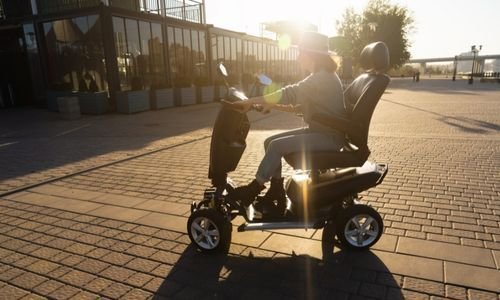How To Choose a Mobility Scooter
Knowing how to choose a mobility scooter can seem overwhelming at first. However, the mobility scooter industry offers distinctive models and characteristics that are more suited to certain uses and users. If you or a loved one has limited mobility, knowing how to find the right mobility scooter will ensure that you can get everywhere you want to go.
Three-Wheel Scooters vs. Four-Wheel Scooters
The first major distinction when it comes to mobility scooters for sale is the number of wheels on the scooter—three or four. In general, a three-wheel electric mobility scooter is best for indoor use because it has a tighter turning radius and a four-wheel scooter is best for outdoor use because it offers more stability.
There are a few additional things to keep in mind when deciding between three-wheel and four-wheel electric scooters:
Three-Wheel Scooters
More legroom for users with long legs or a knee injury
Best maneuverability around objects and in narrow spaces
Often easier to take on public transport
Often more lightweight, compact, and portable
Four-Wheel Scooters
Four-wheel scooters offer more stability and are better for outdoor use and for users with balance issues.
Mid-level and top-tier models can be driven over rougher terrain and even up steep hills.
Heavy-duty models have a higher weight capacity than most three-wheel scooters.
Top-tier models often feature suspension for a more comfortable ride.
Foldable Mobility Scooter vs. Full-Size Mobility Scooters
Whether you prefer a three-wheel or four-wheel electric scooter, there are several different levels available:
Lightweight Mobility Scooter
The lightest-weight mobility scooter is a foldable travel scooter that's designed to fold up or come apart for easy storage and transport. Many rental mobility scooters fall into this category because companies know you aren't likely to invest in a modified van with a vehicle lift or mobility scooter ramp if you'll only need the scooter for a few days or weeks.
While they are easy to transport, lightweight mobility scooters usually drive at lower speeds and have a lower mileage per charge when compared to full-sized models. They also may be limited to driving on smooth surfaces such as the sidewalk or in theme parks and shopping malls.
Full-Size Mobility Scooter
For everyday or long-term use, consider a full-sized scooter—either a mid-level or top-tier heavy-duty model. These motorized scooters are heavier and may not come apart, but that also means they can handle a greater weight capacity and often drive at higher speeds.
The full-sized heavy-duty powered scooter at Mobility Plus in Denver, for example, can drive up to 5 mph and 15 miles on a single charge compared to 4.5 mph and 8 miles per charge for a lightweight rental scooter. The weight capacity is 325 lbs compared to 200 lbs for a basic scooter.
All-Terrain Mobility Scooters
For outdoor use, mid-level and top-tier scooter models can be fitted with all-terrain tires that drive easily over grass, dirt, gravel, sand, and plush carpets. The stronger frame means that you can easily add a carry basket for your shopping, as well as additional features like a cane holder, crutches holder, headrest, speakers—everything but the kitchen sink!
The main differences between mid-level and top-tier scooters are the weight capacities, top speeds, and mileage. Both levels can be fitted with all-terrain tires for outdoor use, plus carry baskets, cane holders, and the like. Scooter users who are especially heavy or tall should choose a powered scooter that is made for their weight and height, as well as the weight of any extras like shopping bags, oxygen tanks, carry baskets, and other accessories.
Mobility Scooter vs. Electric Wheelchair
Finally, understanding the differences between mobility scooters and electric wheelchairs is important when thinking about how to choose a mobility scooter.
As mobility scooters have a central steering column, they are suitable for users who have use of both of their hands. In contrast, electric wheelchairs are steered by a joystick or keypad with one hand, making them more suitable for users who only have one good hand or extremely limited mobility.
In most other respects, power wheelchairs and mobility scooters are very similar. The choice of a mobility scooter vs. an electric wheelchair really comes down to your personal strengths and limitations.
Rent vs. Buy
Depending on the company, it may be possible to rent a mobility scooter rather than buy one outright. If you need the scooter for less than 12 weeks, it's usually more cost-efficient to rent rather than buy. Renting a medical scooter comes with other advantages as well, such as regular maintenance and repairs and the possibility of exchanging the scooter for another model after the rental period is up.
Before you rent a mobility scooter, ask the store representatives whether any of your rental costs can be credited toward the purchase of the scooter. Some stores will credit back half of the first week’s rent toward the purchase of the machine so that you can make sure you’re happy with your chosen model before making the decision to buy.
The Best Mobility Scooter for You
There are many options when it comes to deciding how to choose a mobility scooter, and there really isn't a one-size-fits-all solution. When looking at the best mobility scooters on the market, ask yourself:
Will I mainly drive the scooter inside or outside, and on which terrains?
How far (and fast) do I want to go?
What are my weight and height requirements?
Do I have full use of both of my arms or would an electric wheelchair be better?
Do I need any special features?
Is the scooter within my budget?
Ultimately, the best way to find the right mobility scooter is to visit a mobility showroom to talk with knowledgeable staff. Once you've test-driven a few motorized scooters for yourself, you’ll most likely find a scooter you love.

